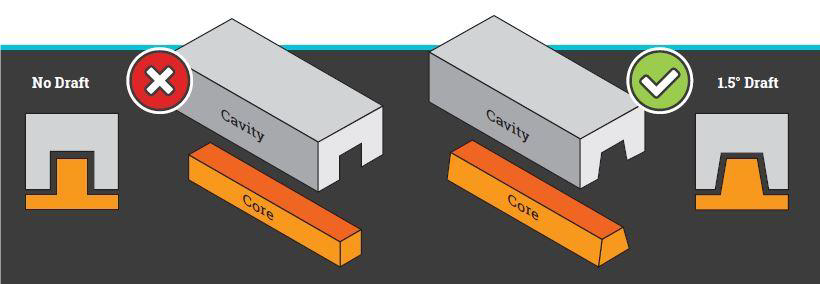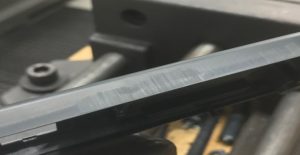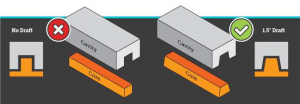
How Draft Can Help To Improve Plastic Injection-Molded Parts
Draft is an angle incorporated into your plastic part design to aid in the ejection process.
Optimize part designs early
Plastic parts should be designed with draft to prevent sticking and ejector pin push marks on the outward surface during ejection. Applying the proper draft angles or tapers on the surface of an injection molded part is critical to part moldability. Often times, draft is not considered when prototyping with CNC machining or 3D printing. It should be considered when either one of these prototypes will ultimately be injection molded. Not incorporating draft into your design upfront can directly result in costing more time and money later on in the manufacturing process.
Potential Pitfalls of Not Including Draft
Without draft being included in the design, parts may bend, have poor surface finishes, break, or warp due to stresses on the molded part. Which, if not dealth with can lead to sticking, breaking, surface finish imperfections and a variety of other issues causing manufacturing delays. In addition, the absence of draft may also damage the mold itself. You do not want your part to look like the photo below.

Proper planning can assist in avoiding costly mistakes.
Best Practices
Although there is not one set draft angle for all plastic injection molded parts, below are some general guidelines:
• 0.5° on vertical applications
• 1.5° to 2° per side are standard for plastic injection molding
• 3° for light texture or shutoff (metal sliding on metal)
• 5° or more for a heavy texture
A good guideline is 1° of draft per 1” of cavity depth however keep in mind that a variety of factors will influence this such as material selection, wall thickness, shrink rates and manufacturing capabilities.

Do you questions or concerns about draft? Upload your design today at xcentricmold.dev.varcm.com or let one of our Technical Experts assist you by contacting us a 586-598-4636 or email sales@xcentricmold.com. It is a good way of avoiding future moldability issues.
For additional information on draft, click draft.